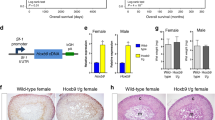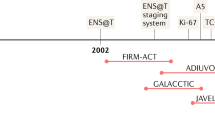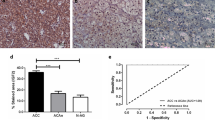Abstract
The currently available medical treatment options of adrenocortical cancer (ACC) are limited. In our previous meta-analysis of adrenocortical tumor genomics data, ACC was associated with reduced retinoic acid production and retinoid X receptor-mediated signaling. Our objective has been to study the potential antitumoral effects of 9-cis retinoic acid (9-cisRA) on the ACC cell line NCI-H295R and in a xenograft model. Cell proliferation, hormone secretion, and gene expression have been studied in the NCI-H295R cell line. A complex bioinformatics approach involving pathway and network analysis has been performed. Selected genes have been validated by real-time qRT-PCR. Athymic nude mice xenografted with NCI-H295R have been used in a pilot in vivo xenograft model. 9-cisRA significantly decreased cell viability and steroid hormone secretion in a concentration- and time-dependent manner in the NCI-H295R cell line. Four major molecular pathways have been identified by the analysis of gene expression data. Ten genes have been successfully validated involved in: (1) steroid hormone secretion (HSD3B1, HSD3B2), (2) retinoic acid signaling (ABCA1, ABCG1, HMGCR), (3) cell-cycle damage (GADD45A, CCNE2, UHRF1), and the (4) immune response (MAP2K6, IL1R2). 9-cisRA appears to directly regulate the cell cycle by network analysis. 9-cisRA also reduced tumor growth in the in vivo xenograft model. In conclusion, 9-cisRA might represent a promising new candidate in the treatment of hormone-secreting adrenal tumors and adrenocortical cancer.






Similar content being viewed by others
References
Fassnacht M, Libe R, Kroiss M, Allolio B (2011) Adrenocortical carcinoma: a clinician’s update. Nat Rev Endocrinol 7(6):323–335. doi:10.1038/nrendo.2010.235
Lafemina J, Brennan MF (2012) Adrenocortical carcinoma: past, present, and future. J Surg Oncol 106(5):586–594. doi:10.1002/jso.23112
Libe R, Fratticci A, Bertherat J (2007) Adrenocortical cancer: pathophysiology and clinical management. Endocr Relat Cancer 14(1):13–28. doi:10.1677/erc.1.01130
Fassnacht M, Terzolo M, Allolio B, Baudin E, Haak H, Berruti A, Welin S, Schade-Brittinger C, Lacroix A, Jarzab B, Sorbye H, Torpy DJ, Stepan V, Schteingart DE, Arlt W, Kroiss M, Leboulleux S, Sperone P, Sundin A, Hermsen I, Hahner S, Willenberg HS, Tabarin A, Quinkler M, de la Fouchardiere C, Schlumberger M, Mantero F, Weismann D, Beuschlein F, Gelderblom H, Wilmink H, Sender M, Edgerly M, Kenn W, Fojo T, Muller HH, Skogseid B (2012) Combination chemotherapy in advanced adrenocortical carcinoma. N Engl J Med 366(23):2189–2197. doi:10.1056/NEJMoa1200966
Terzolo M, Ardito A, Zaggia B, Laino F, Germano A, De Francia S, Daffara F, Berruti A (2012) Management of adjuvant mitotane therapy following resection of adrenal cancer. Endocrine 42(3):521–525. doi:10.1007/s12020-012-9719-7
Hahner S, Fassnacht M (2005) Mitotane for adrenocortical carcinoma treatment. Curr Opin Investig Drugs 6(4):386–394
Szabo PM, Tamasi V, Molnar V, Andrasfalvy M, Tombol Z, Farkas R, Kovesdi K, Patocs A, Toth M, Szalai C, Falus A, Racz K, Igaz P (2010) Meta-analysis of adrenocortical tumour genomics data: novel pathogenic pathways revealed. Oncogene 29(21):3163–3172. doi:10.1038/onc.2010.80
Ferruzzi P, Ceni E, Tarocchi M, Grappone C, Milani S, Galli A, Fiorelli G, Serio M, Mannelli M (2005) Thiazolidinediones inhibit growth and invasiveness of the human adrenocortical cancer cell line H295R. J Clin Endocrinol Metab 90(3):1332–1339. doi:10.1210/jc.2004-0978
Perez E, Bourguet W, Gronemeyer H, de Lera AR (2012) Modulation of RXR function through ligand design. Biochim Biophys Acta 1821(1):57–69. doi:10.1016/j.bbalip.2011.04.003
Shimizu M, Takai K, Moriwaki H (2009) Strategy and mechanism for the prevention of hepatocellular carcinoma: phosphorylated retinoid X receptor alpha is a critical target for hepatocellular carcinoma chemoprevention. Cancer Sci 100(3):369–374. doi:10.1111/j.1349-7006.2008.01045.x
Ganslmayer M, Ocker M, Kraemer G, Zopf S, Hahn EG, Schuppan D, Herold C (2004) The combination of tamoxifen and 9cis retinoic acid exerts overadditive anti-tumoral efficacy in rat hepatocellular carcinoma. J Hepatol 40(6):952–956. doi:10.1016/j.jhep.2004.02.004
Tatebe H, Shimizu M, Shirakami Y, Tsurumi H, Moriwaki H (2008) Synergistic growth inhibition by 9-cis-retinoic acid plus trastuzumab in human hepatocellular carcinoma cells. Clin Cancer Res 14(9):2806–2812. doi:10.1158/1078-0432.CCR-07-4708
Cope MB, Steele VE, Lubet RA, Eto I, Juliana MM, Hill DL, Grubbs CJ (2004) Efficacy of 9-cis-retinoic acid and N-(4-hydroxyphenyl) retinamide alone and in combination in mammary cancer prevention. Oncol Rep 11(2):465–469
Maeng S, Kim GJ, Choi EJ, Yang HO, Lee DS, Sohn YC (2012) 9-Cis-retinoic acid induces growth inhibition in retinoid-sensitive breast cancer and sea urchin embryonic cells via retinoid X receptor alpha and replication factor C3. Mol Endocrinol 26(11):1821–1835. doi:10.1210/me.2012-1104
Fatahzadeh M (2011) Kaposi sarcoma: review and medical management update. Oral Surg Oral Med Oral Pathol Oral Radiol Endod. doi:10.1016/j.tripleo.2011.05.011
Lawrence JA, Adamson PC, Caruso R, Chow C, Kleiner D, Murphy RF, Venzon DJ, Shovlin M, Noone M, Merino M, Cowan KH, Kaiser M, O’Shaughnessy J, Zujewski J (2001) Phase I clinical trial of alitretinoin and tamoxifen in breast cancer patients: toxicity, pharmacokinetic, and biomarker evaluations. J Clin Oncol 19(10):2754–2763
Zsippai A, Szabo DR, Tombol Z, Szabo PM, Eder K, Pallinger E, Gaillard RC, Patocs A, Toth S, Falus A, Racz K, Igaz P (2012) Effects of mitotane on gene expression in the adrenocortical cell line NCI-H295R: a microarray study. Pharmacogenomics 13(12):1351–1361. doi:10.2217/pgs.12.116
Goon PK, Boos CJ, Stonelake PS, Blann AD, Lip GY (2006) Detection and quantification of mature circulating endothelial cells using flow cytometry and immunomagnetic beads: a methodological comparison. Thromb Haemost 96(1):45–52. doi:10.1160/TH06-04-0185
de Reynies A, Assie G, Rickman DS, Tissier F, Groussin L, Rene-Corail F, Dousset B, Bertagna X, Clauser E, Bertherat J (2009) Gene expression profiling reveals a new classification of adrenocortical tumors and identifies molecular predictors of malignancy and survival. J Clin Oncol 27(7):1108–1115. doi:10.1200/JCO.2008.18.5678
Giordano TJ, Kuick R, Else T, Gauger PG, Vinco M, Bauersfeld J, Sanders D, Thomas DG, Doherty G, Hammer G (2009) Molecular classification and prognostication of adrenocortical tumors by transcriptome profiling. Clin Cancer Res 15(2):668–676. doi:10.1158/1078-0432.CCR-08-1067
Tombol Z, Szabo PM, Molnar V, Wiener Z, Tolgyesi G, Horanyi J, Riesz P, Reismann P, Patocs A, Liko I, Gaillard RC, Falus A, Racz K, Igaz P (2009) Integrative molecular bioinformatics study of human adrenocortical tumors: microRNA, tissue-specific target prediction, and pathway analysis. Endocr Relat Cancer 16(3):895–906. doi:10.1677/ERC-09-0096
Giordano TJ, Thomas DG, Kuick R, Lizyness M, Misek DE, Smith AL, Sanders D, Aljundi RT, Gauger PG, Thompson NW, Taylor JM, Hanash SM (2003) Distinct transcriptional profiles of adrenocortical tumors uncovered by DNA microarray analysis. Am J Pathol 162(2):521–531. doi:10.1016/S0002-9440(10)63846-1
Fernandez-Ranvier GG, Weng J, Yeh RF, Khanafshar E, Suh I, Barker C, Duh QY, Clark OH, Kebebew E (2008) Identification of biomarkers of adrenocortical carcinoma using genomewide gene expression profiling. Arch Surg 143(9):841–846. doi:10.1001/archsurg.143.9.841 (discussion 846)
Fernandez-Ranvier GG, Weng J, Yeh RF, Shibru D, Khafnashar E, Chung KW, Hwang J, Duh QY, Clark OH, Kebebew E (2008) Candidate diagnostic markers and tumor suppressor genes for adrenocortical carcinoma by expression profile of genes on chromosome 11q13. World J Surg 32(5):873–881. doi:10.1007/s00268-008-9521-0
Laurell C, Velazquez-Fernandez D, Lindsten K, Juhlin C, Enberg U, Geli J, Hoog A, Kjellman M, Lundeberg J, Hamberger B, Larsson C, Nilsson P, Backdahl M (2009) Transcriptional profiling enables molecular classification of adrenocortical tumours. Eur J Endocrinol 161(1):141–152. doi:10.1530/EJE-09-0068
Slater EP, Diehl SM, Langer P, Samans B, Ramaswamy A, Zielke A, Bartsch DK (2006) Analysis by cDNA microarrays of gene expression patterns of human adrenocortical tumors. Eur J Endocrinol 154(4):587–598. doi:10.1530/eje.1.02116
Soon PS, Gill AJ, Benn DE, Clarkson A, Robinson BG, McDonald KL, Sidhu SB (2009) Microarray gene expression and immunohistochemistry analyses of adrenocortical tumors identify IGF2 and Ki-67 as useful in differentiating carcinomas from adenomas. Endocr Relat Cancer 16(2):573–583. doi:10.1677/ERC-08-0237
West AN, Neale GA, Pounds S, Figueredo BC, Rodriguez Galindo C, Pianovski MA, Oliveira Filho AG, Malkin D, Lalli E, Ribeiro R, Zambetti GP (2007) Gene expression profiling of childhood adrenocortical tumors. Cancer Res 67(2):600–608. doi:10.1158/0008-5472.CAN-06-3767
Friedel CC, Zimmer R (2007) Influence of degree correlations on network structure and stability in protein–protein interaction networks. BMC Bioinforma 8:297. doi:10.1186/1471-2105-8-297
Jothi R, Balaji S, Wuster A, Grochow JA, Gsponer J, Przytycka TM, Aravind L, Babu MM (2009) Genomic analysis reveals a tight link between transcription factor dynamics and regulatory network architecture. Mol Syst Biol 5:294. doi:10.1038/msb.2009.52
Milo R, Shen-Orr S, Itzkovitz S, Kashtan N, Chklovskii D, Alon U (2002) Network motifs: simple building blocks of complex networks. Science 298(5594):824–827. doi:10.1126/science.298.5594.824
Ayaori M, Yakushiji E, Ogura M, Nakaya K, Hisada T, Uto-Kondo H, Takiguchi S, Terao Y, Sasaki M, Komatsu T, Iizuka M, Yogo M, Uehara Y, Kagechika H, Nakanishi T, Ikewaki K (2012) Retinoic acid receptor agonists regulate expression of ATP-binding cassette transporter G1 in macrophages. Biochim Biophys Acta 1821(4):561–572. doi:10.1016/j.bbalip.2012.02.004
Livak KJ, Schmittgen TD (2001) Analysis of relative gene expression data using real-time quantitative PCR and the 2(-Delta Delta C(T)) method. Methods 25(4):402–408. doi:10.1006/meth.2001.1262
Larionov A, Krause A, Miller W (2005) A standard curve-based method for relative real-time PCR data processing. BMC Bioinforma 6:62. doi:10.1186/1471-2105-6-62
Cheng WC, Chang CW, Chen CR, Tsai ML, Shu WY, Li CY, Hsu IC (2011) Identification of reference genes across physiological states for qRT-PCR through microarray meta-analysis. PLoS ONE 6(2):e17347. doi:10.1371/journal.pone.0017347
Logie A, Boudou P, Boccon-Gibod L, Baudin E, Vassal G, Schlumberger M, Le Bouc Y, Gicquel C (2000) Establishment and characterization of a human adrenocortical carcinoma xenograft model. Endocrinology 141(9):3165–3171
Luconi M, Mangoni M, Gelmini S, Poli G, Nesi G, Francalanci M, Pratesi N, Cantini G, Lombardi A, Pepi M, Ercolino T, Serio M, Orlando C, Mannelli M (2010) Rosiglitazone impairs proliferation of human adrenocortical cancer: preclinical study in a xenograft mouse model. Endocr Relat Cancer 17(1):169–177. doi:10.1677/ERC-09-0170
Appleyard VC, O’Neill MA, Murray KE, Bray SE, Thomson G, Kernohan NM, Varani J, Zhang J, Thompson AM (2004) Activity of MDI-301, a novel synthetic retinoid, in xenografts. Anticancer Drugs 15(10):991–996 (pii:00001813-200411000-00009)
Gazdar AF, Oie HK, Shackleton CH, Chen TR, Triche TJ, Myers CE, Chrousos GP, Brennan MF, Stein CA, La Rocca RV (1990) Establishment and characterization of a human adrenocortical carcinoma cell line that expresses multiple pathways of steroid biosynthesis. Cancer Res 50(17):5488–5496
Simard JRM, Gingras S, Soucy P, Feltus FA, Melner MH (2005) Molecular biology of the 3β-hydroxysteroid dehydrogenase/Δ5-Δ4 isomerase gene family. Endocr Rev 26(4):525–582
Bassett MH, Mayhew B, Rehman K, White PC, Mantero F, Arnaldi G, Stewart PM, Bujalska I, Rainey WE (2005) Expression profiles for steroidogenic enzymes in adrenocortical disease. J Clin Endocrinol Metab 90(9):5446–5455. doi:10.1210/jc.2005-0836
Lefevre A, Rogier E, Astraudo C, Duquenne C, Finaz C (1994) Regulation by retinoids of luteinizing hormone/chorionic gonadotropin receptor, cholesterol side-chain cleavage cytochrome P-450, 3 beta-hydroxysteroid dehydrogenase/delta (5-4)-isomerase and 17 alpha-hydroxylase/C17-20 lyase cytochrome P-450 messenger ribonucleic acid levels in the K9 mouse Leydig cell line. Mol Cell Endocrinol 106(1–2):31–39
Paez-Pereda M, Kovalovsky D, Hopfner U, Theodoropoulou M, Pagotto U, Uhl E, Losa M, Stalla J, Grubler Y, Missale C, Arzt E, Stalla GK (2001) Retinoic acid prevents experimental Cushing syndrome. J Clin Invest 108(8):1123–1131. doi:10.1172/jci11098
Cummins CL, Volle DH, Zhang Y, McDonald JG, Sion B, Lefrancois-Martinez AM, Caira F, Veyssiere G, Mangelsdorf DJ, Lobaccaro JM (2006) Liver X receptors regulate adrenal cholesterol balance. J Clin Invest 116(7):1902–1912. doi:10.1172/JCI28400
Tojima H, Kakizaki S, Yamazaki Y, Takizawa D, Horiguchi N, Sato K, Mori M (2012) Ligand-dependent hepatic gene expression profiles of nuclear receptors CAR and PXR. Toxicol Lett 212(3):288–297. doi:10.1016/j.toxlet.2012.06.001
Aleksunes LM, Klaassen CD (2012) Coordinated regulation of hepatic phase I and II drug-metabolizing genes and transporters using AhR-, CAR-, PXR-, PPARalpha-, and Nrf2-null mice. Drug Metab Dispos 40(7):1366–1379. doi:10.1124/dmd.112.045112
Yamazaki K, Shimizu M, Okuno M, Matsushima-Nishiwaki R, Kanemura N, Araki H, Tsurumi H, Kojima S, Weinstein IB, Moriwaki H (2007) Synergistic effects of RXR alpha and PPAR gamma ligands to inhibit growth in human colon cancer cells–phosphorylated RXR alpha is a critical target for colon cancer management. Gut 56(11):1557–1563. doi:10.1136/gut.2007.129858
Elferink CJ (2003) Aryl hydrocarbon receptor-mediated cell cycle control. Prog Cell Cycle Res 5:261–267
Jang ER, Choi JD, Park MA, Jeong G, Cho H, Lee JS (2010) ATM modulates transcription in response to histone deacetylase inhibition as part of its DNA damage response. Exp Mol Med 42(3):195–204 pii:emm.2010.42.020
Liebermann DA, Tront JS, Sha X, Mukherjee K, Mohamed-Hadley A, Hoffman B (2011) Gadd45 stress sensors in malignancy and leukemia. Crit Rev Oncog 16(1–2):129–140 (pii:049e8a5e62fb019e,70f927fe5a67ad86)
Wang G, Chan CH, Gao Y, Lin HK (2012) Novel roles of Skp2 E3 ligase in cellular senescence, cancer progression, and metastasis. Chin J Cancer 31(4):169–177. doi:10.5732/cjc.011.10319
Unoki M, Brunet J, Mousli M (2009) Drug discovery targeting epigenetic codes: the great potential of UHRF1, which links DNA methylation and histone modifications, as a drug target in cancers and toxoplasmosis. Biochem Pharmacol 78(10):1279–1288. doi:10.1016/j.bcp.2009.05.035
Szabo PM, Racz K, Igaz P (2011) Underexpression of C-myc in adrenocortical cancer: a major pathogenic event? Horm Metab Res 43(5):297–299. doi:10.1055/s-0031-1273762
Pusapati RV, Weaks RL, Rounbehler RJ, McArthur MJ, Johnson DG (2010) E2F2 suppresses Myc-induced proliferation and tumorigenesis. Mol Carcinog 49(2):152–156. doi:10.1002/mc.20584
Mangan S, Alon U (2003) Structure and function of the feed-forward loop network motif. Proc Natl Acad Sci USA 100(21):11980–11985. doi:10.1073/pnas.2133841100
Cuadrado A, Nebreda AR (2010) Mechanisms and functions of p38 MAPK signalling. Biochem J 429(3):403–417. doi:10.1042/BJ20100323
Popa C, van Lieshout AW, Roelofs MF, Geurts-Moespot A, van Riel PL, Calandra T, Sweep FC, Radstake TR (2006) MIF production by dendritic cells is differentially regulated by Toll-like receptors and increased during rheumatoid arthritis. Cytokine 36(1–2):51–56. doi:10.1016/j.cyto.2006.10.011
Hankins JL, Fox TE, Barth BM, Unrath KA, Kester M (2011) Exogenous ceramide-1-phosphate reduces lipopolysaccharide (LPS)-mediated cytokine expression. J Biol Chem 286(52):44357–44366. doi:10.1074/jbc.M111.264010
Kanczkowski W, Tymoszuk P, Ehrhart-Bornstein M, Wirth MP, Zacharowski K, Bornstein SR (2010) Abrogation of TLR4 and CD14 expression and signaling in human adrenocortical tumors. J Clin Endocrinol Metab 95(12):E421–E429. doi:10.1210/jc.2010-1100
John CD, Buckingham JC (2003) Cytokines: regulation of the hypothalamo-pituitary-adrenocortical axis. Curr Opin Pharmacol 3(1):78–84 (pii:S1471489202000097)
O’Neill LA (2008) The interleukin-1 receptor/Toll-like receptor superfamily: 10 years of progress. Immunol Rev 226:10–18. doi:10.1111/j.1600-065X.2008.00701.x
Bissonnette R, Worm M, Gerlach B, Guenther L, Cambazard F, Ruzicka T, Maares J, Brown TC (2010) Successful retreatment with alitretinoin in patients with relapsed chronic hand eczema. Br J Dermatol 162(2):420–426. doi:10.1111/j.1365-2133.2009.09572.x
Acknowledgments
This study has been funded by the Hungarian Scientific Research Fund (OTKA K100295).
Author information
Authors and Affiliations
Corresponding author
Electronic supplementary material
Below is the link to the electronic supplementary material.
18_2013_1408_MOESM1_ESM.tif
Supplementary Figure 1 Association of cell viability (A) and DHEA concentrations (B) with treatment periods (TIFF 698 kb)
18_2013_1408_MOESM2_ESM.tif
Supplementary Figure 2 Hierarchical clustering of gene expression following flag (100 % present in at least one group) and fold change (fold change > 2) filtering of microarray results. Hierarchical clustering was performed by GeneSpring software 10.1. NCI-H295R cells were incubated with ethanol (control groups) and with 9-cisRA for 24 h in three different concentration. The rows represent the individual genes. The gene expression levels are displayed in each independent sample. Both genes and the groups were clustered by centroid linkage method calculating with Euclidean distance. Overexpression is indicated with red, underexpression is represented with blue (TIFF 962 kb)
18_2013_1408_MOESM3_ESM.tif
Supplementary Figure 3 Pathways with related gene expression patterns involved in cells-cycle regulation (aryl hydrocarbon receptor (AHR) signaling, cyclins and cell-cycle regulation and the estrogen-mediated S-phase entry pathways) after 9-cisRA treatment in NCI-H295R cells (left sides of circular symbols representing gene expression) and investigated microarray studies in ACC (right sides of circular symbols representing gene expression) (TIFF 822 kb)
18_2013_1408_MOESM4_ESM.tif
Supplementary Figure 4 Pathways with related gene expression patterns involved in the immune regulation after 9-cisRA treatment in NCI-H295R cells (left sides of circular symbols representing gene expression) and investigated microarray studies in ACC (right sides of circular symbols representing gene expression) (TIFF 1023 kb)
18_2013_1408_MOESM5_ESM.tif
Supplementary Figure 5 Gene expression network with altered gene expression patterns and feed-forward loop (FFL) motifs after 9-cisRA treatment in NCI-H295R cells (TIFF 765 kb)
18_2013_1408_MOESM6_ESM.tif
Supplementary Figure 6 Correlation between gene expression changes and 9-cisRA concentrations for eight genes by Spearman correlation. A: CCNE2, B: GADD45A, C: HSD3B1, D: HSD3B2, E: IL1R2. F: MAP2K6, G: HMGCR, H: UHRF1 (p value < 0.05, R2 > 0.7) (TIFF 702 kb)
18_2013_1408_MOESM7_ESM.xlsx
Supplementary Table 1 List of 699, 2,320, and 2,303 significantly differentially expressed genes between control and the 2.5 × 10−5M, 5 × 10−5M and 7.5 × 10−5M 9-cisRA-treated cell cultures, respectively at 24 h (p < 0.05) (XLSX 171 kb)
18_2013_1408_MOESM8_ESM.xlsx
Supplementary Table 2 List of 246 detected genes that were common in at least two comparisons of control and 9-cisRA-treated groups and in at least two former ACA and ACC microarray studies (p < 0.05) (XLSX 31 kb)
18_2013_1408_MOESM9_ESM.xlsx
Supplementary Table 3 List of 21 significant canonical pathways in at least two comparisons of control and 9-cisRA-treated groups and in at least two ACA and ACC microarray studies (p < 0.05) (XLSX 20 kb)
Rights and permissions
About this article
Cite this article
Szabó, D.R., Baghy, K., Szabó, P.M. et al. Antitumoral effects of 9-cis retinoic acid in adrenocortical cancer. Cell. Mol. Life Sci. 71, 917–932 (2014). https://doi.org/10.1007/s00018-013-1408-z
Received:
Revised:
Accepted:
Published:
Issue Date:
DOI: https://doi.org/10.1007/s00018-013-1408-z




